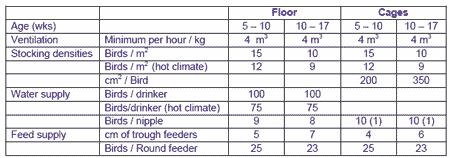From 4 to 16 weeks, building the potential of the future layer

After a good starting, the objective of the 4-16 weeks period is to prepare the birds for egg production with an ideal development of:
- the frame
- the bodyweight
- the uniformity
- the digestive tract development
These objectives could be achieved thanks to:
- a correct stocking density and housing conditions
- a lighting programme adapted to rearing conditions
- a good standard of beak tipping
- a good management of the feeding programme and feeding techniques
Housing and equipment
(1): Make sure that all the birds have at least an access to 2 nipples
Feeding programme
The range of diet advised for the rearing period could be adapted to the real evolution of the frame and bodyweight development of the pullets.
Starter diet recommended from day old till 4 weeks old could be extended till 5 or 6 weeks to secure the frame development. Frame development is done for the large part during the first 8 weeks of the rearing period.
Grower diet recommended from 4 weeks till 10 weeks old could be extended till 11 or 12 weeks old in order to secure growth. As the rearing period objective is also to develop the digestive tract, this grower diet usually high in energy content could not be given after 12 weeks old. The risk being to reduce the development of the digestive tract and the feed intake at start of lay by using too high energy content feed.
The distribution of a developer diet till 16 weeks will help the development of the crop capacity thanks to a lower energy level than grower feed and slightly lower than the pre-lay or layer feed.
In order to secure the development of the medulary bone which acts as a reservoir of
mobilisable calcium for egg shell formation, we advised to use a pre lay feed from 17 weeks till the first eggs appear.
The details specification for each of those diets are developed in a following chapter.
Feeding technique
The feeding techniques used between 4 and 16 weeks are designed to:
- avoid the build up of fine particle residues
- encourage crop development by having rapid feed consumption
- The Build Up of Fine Particle Residues
Birds are by nature grain feeders. They always start by eating the larger particles and leave the finer ones. The accumulation of fine particles in the feeding system leads to underconsumption.
Therefore, it is essential that the feeders are emptied every day. This rule applies equally to pullets and layers.
- Rapid Feed Intake
The crop is a storage organ. It allows the bird to eat enough feed in the evening to satisfy its energy needs throughout the night. The increase in consumption at start of lay is dependent on the development of the crop and on the feeding behaviour acquired during rearing.
Rapid feed consumption during rearing leads to the development of the crop. The speed with which feed is eaten depends on when it is fed and on the form in which it is offered.
- Feeding Times and rapid feed intake
Birds naturally eat more in the morning and evening. For that reason the feeders ought to be empty in the middle of the day.
To encourage rapid consumption, we recommend that the complete daily ration should be given about 2 to 3 hours before the lights go out. The actual time of feed issue should be chosen so that about 50 % is eaten the following morning. At "lights on", because the digestive system is empty, the birds will eat up the finer particles better. This feeding routine can be started between 4 and 8 according to the feeding equipment. The length of time, during which the feeders are empty, should be gradually increased, so that by around 10-12 weeks of age the feeders are empty for a minimum of 2 to 3 hours per day. It is, however, possible according to the feeding equipment to give either a single feed distribution in either the morning or evening, or two 2 distributions, provided that the feeding periods are kept short.
Weekly bird weighing is essential, so that the appropriate quantity of feed to issue can be calculated.
The gizzard development could be encourage thanks to a good feed presentation and the use of insoluble grit. You will find more details on these points in the “nutrition in rearing” chapter.









_%20Why%20are%20egg%20prices%20on%20the%20rise(10min).jpg&w=3840&q=75)